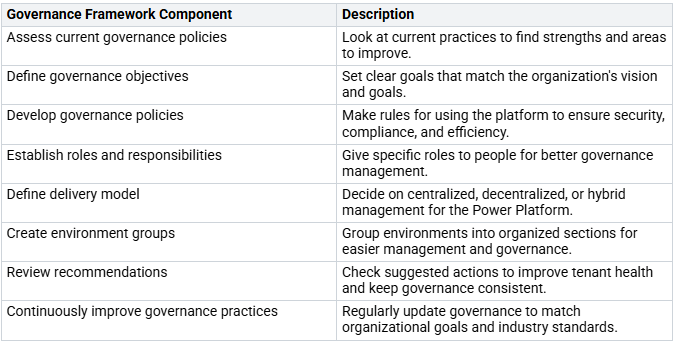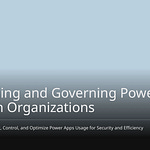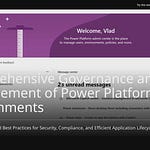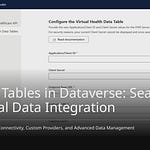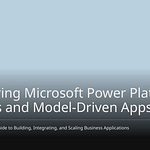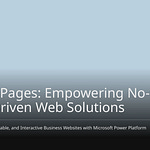In today’s digital world, organizations need to innovate and stay secure. You must focus on governance and security to keep your data safe. Without a strong plan, you could face compliance issues and security problems. Knowing how important these things are is key for any business using the Power Platform. By using good governance and security practices, you can encourage innovation while protecting your resources.
Key Takeaways
Good governance in the Power Platform helps control risks. It also keeps data safe and encourages new ideas.
Use Data Loss Prevention (DLP) rules to guard important information. This stops data leaks from happening.
Set clear roles and tasks to boost teamwork. This makes governance work better.
Form a governance board to watch over citizen development projects. This ensures they follow organizational rules.
Check and update governance practices often. This keeps them in line with industry standards and goals.
Governance and Security Overview
Governance and security are very important in the Power Platform. They help your organization create new ideas while keeping sensitive data safe. A strong governance plan helps you manage applications well. It also protects your data from possible threats. Without good governance and security, you could face big problems.
Organizations often face different challenges when managing applications and data. Here are some common issues:
Limited controls to stop attackers: Business applications may not have enough ways to block unauthorized access, making them easy targets for attacks.
Insider threats: Users with permissions can misuse their access, needing better security measures to find and reduce these risks.
Subtle attacks: Small changes made by attackers can go unnoticed, showing the need for strong monitoring and analysis.
These challenges can lead to serious problems for your organization. Poor governance can cause:
Decreased data quality: Inconsistent, wrong, or incomplete data can lead to bad decisions.
Compliance failures: Weak governance can cause you to break rules, leading to fines and damage to your reputation.
Security breaches: Weak governance raises the chance of data breaches, which can cost money and lead to legal issues.
To fight these problems, you must focus on governance and security in your Power Platform plan. By doing this, you can build a safe environment that encourages innovation while keeping your data protected and following the rules.
Power Platform Governance Framework
A good governance framework is very important for organizations using the Power Platform. It gives a clear plan for managing applications, data, and workflows. With a strong framework, you can make sure your governance practices match your organization’s goals. This helps you keep control while encouraging new ideas.
Here are key parts of a good governance framework:
Using a governance framework helps you balance new ideas and following rules. For example, Company X set up a Power Platform Center of Excellence (CoE) to handle security, compliance, and operations while allowing innovation. This framework was made to fit the organization’s needs, covering all risks. Working together across different teams was key to making a strong governance framework that supports ongoing innovation.
Good governance programs teach users about responsible innovation. They create a partnership between IT and business teams, helping you innovate with confidence. Governance acts like a safety net, allowing you to speed up innovation while keeping necessary rules in place. For example, using a tiered environment strategy lets you experiment in development while keeping control in production. Data Loss Prevention (DLP) policies manage connector use, protecting sensitive data while allowing new ideas. Role management makes sure employees have the right access, balancing freedom with security.
By using a structured governance framework, you can see real results. This method balances innovation and control, encourages cultural change, and grows citizen development. It empowers business users while giving expert help and support. In the end, it links low-code projects to business goals and return on investment (ROI).
Governance Best Practices
To have good governance in the Power Platform, you should follow some best practices. These practices help you manage your apps and data well while keeping them safe and following the rules. Here are some important tips:
Set up rules to prevent data loss.
Use built-in activity logs and analytics.
Set up and automate your audit process.
Welcome new makers and find champions.
Using these best practices for Power Platform management helps you build a strong governance plan. Each practice helps keep your environment safe and compliant, allowing new ideas without risking data safety.
Stakeholders are very important for successful governance efforts. Knowing roles clearly is key for using the Power Platform well. When you define clear roles and responsibilities, it helps teamwork and avoids confusion. This clarity makes sure everyone takes part in the governance process effectively.
Understanding stakeholders and their roles can help align with project goals, manage changes well, and lead to successful platform use.
Getting stakeholders involved improves decision-making and strengthens governance. Here are some benefits of good stakeholder engagement:
Including stakeholder input in planning improves decisions.
Governance tools help manage complex stakeholder relationships.
Proactive stakeholder governance boosts compliance and risk management.
By following these best practices and involving stakeholders, you can create a governance structure that supports new ideas while ensuring safety and compliance.
Security Measures in Power Platform
In the Power Platform, security measures are very important for keeping your organization’s data safe. You can use different features to make sure that sensitive information stays protected. Here are some key security features in the Power Platform:
Make sure personal information is handled, stored, and protected securely.
Stop unauthorized access to data and keep apps safe from cyberattacks.
Use customer-managed encryption keys to manage data encryption.
Apply data policies to lower the chance of accidental data exposure.
Use Azure Virtual Network policies to separate network traffic and enforce security.
Role-Based Access Control
Role-Based Access Control (RBAC) improves security by controlling who can access certain resources in the Power Platform. This method lets you give roles based on job duties. Here’s how RBAC works:
By using RBAC, you can make sure that only authorized users can access sensitive data. This reduces the chance of data breaches and improves overall security.
Data Loss Prevention Policies
Data Loss Prevention (DLP) policies are very important for protecting sensitive information in the Power Platform. These policies limit how data moves across connectors, helping to stop data leaks. Here are some key points about DLP policies:
Strong Data Loss Prevention (DLP) policies are key for reducing data leaks in Power Platform environments. Custom DLP policies control data connectors in different environments, ensuring compliance and lowering risks related to data exposure.
To effectively use DLP policies, think about these strategies:
Define which services can share data to avoid unintended leaks.
Know how data flows across connectors to spot high-risk interactions.
Classify and group connectors wisely to match security policies.
Regularly check and update DLP policies to keep up with new threats and rules.
By setting up strong DLP policies, you create a barrier against data theft and compliance issues. This proactive approach boosts your security and lowers the risk of accidental data exposure.
Compliance and Risk Management
Compliance is very important for organizations using the Power Platform. You need to know the rules that affect your work. Here are some important compliance points:
Organizations must follow data residency rules. This means data must be stored where the law says.
Following rules like GDPR, HIPAA, and CCPA is very important.
Regular compliance checks should be done to make sure you follow the rules.
Training employees on how to protect data is key for compliance.
To make sure you comply, do these steps:
Find out what rules apply to your industry and follow them.
Put in place controls to ensure compliance.
Check the rules for where to store and manage data.
Unmanaged applications can create big risks for your organization. These risks can cause compliance problems and security issues. Here’s a table showing common risks and how to reduce them:
Using custom connectors the wrong way can lead to compliance problems. This misuse can break data loss prevention (DLP) rules, allowing unauthorized access to blocked connectors. You need to watch and limit the use of custom connectors to avoid these compliance issues. By using strong monitoring methods, you can protect your data and keep compliant effectively.
Citizen Development and Governance
Citizen development is very important for governance in the Power Platform. When you let non-technical users make applications, it can boost innovation and efficiency. But without good governance, this can create problems. A strong governance framework makes sure that citizen development helps your organization’s goals. This framework keeps security and compliance while letting teams be creative.
To support citizen developers in a responsible way, you need clear governance policies. Set up a governance board to watch over citizen development projects. This board can help manage risks and make sure projects meet organizational standards. Giving thorough training is also very important. You can create training programs for different skill levels. Ask for feedback from citizen developers to make these initiatives better. Encourage a culture of continuous learning by providing useful resources.
Here are some ways to support citizen developers while keeping governance in mind:
Establish clear governance policies: Set rules and expectations for citizen development.
Create a governance board: This group can oversee projects and check for compliance.
Provide comprehensive training: Give citizen developers the skills they need to do well.
Encourage feedback: Use input from developers to improve training and governance.
Promote continuous learning: Offer resources to help developers stay updated on best practices.
By using these strategies, you can create a responsible citizen development environment. This way, you can use your teams’ creativity while keeping governance important. In the end, good governance improves your organization’s structure, helping citizen developers succeed.
In conclusion, good governance and security in the Power Platform are very important for your organization’s success. By using clear frameworks and best practices, you can encourage new ideas while keeping data safe and following the rules. Remember these main points:
Sort data by sensitivity and use Data Loss Prevention (DLP) controls.
Set up clear approval steps for guest access with Azure AD.
Train makers on the best ways to handle sensitive data.
By focusing on these strategies, you help your teams innovate safely while protecting your organization’s important assets. 🌟
FAQ
Why is governance important in Power Platform?
Governance in Power Platform keeps your apps and data safe. It helps you manage risks, follow rules, and keep data quality high while encouraging new ideas.
How do I set up Data Loss Prevention (DLP) policies?
You can set up DLP policies by deciding which services can share data. Check and update these policies often to deal with new threats and stay compliant.
What does Role-Based Access Control (RBAC) do?
RBAC controls who can access resources based on their roles. It makes sure only authorized users can see sensitive data, lowering the chance of data breaches.
How can I help citizen developers?
You can help citizen developers by making clear governance rules, giving thorough training, and forming a governance board to check projects and ensure compliance.
What are the dangers of unmanaged applications?
Unmanaged applications can cause compliance issues, security problems, and data loss. Regular checks and good governance practices can help reduce these dangers.


